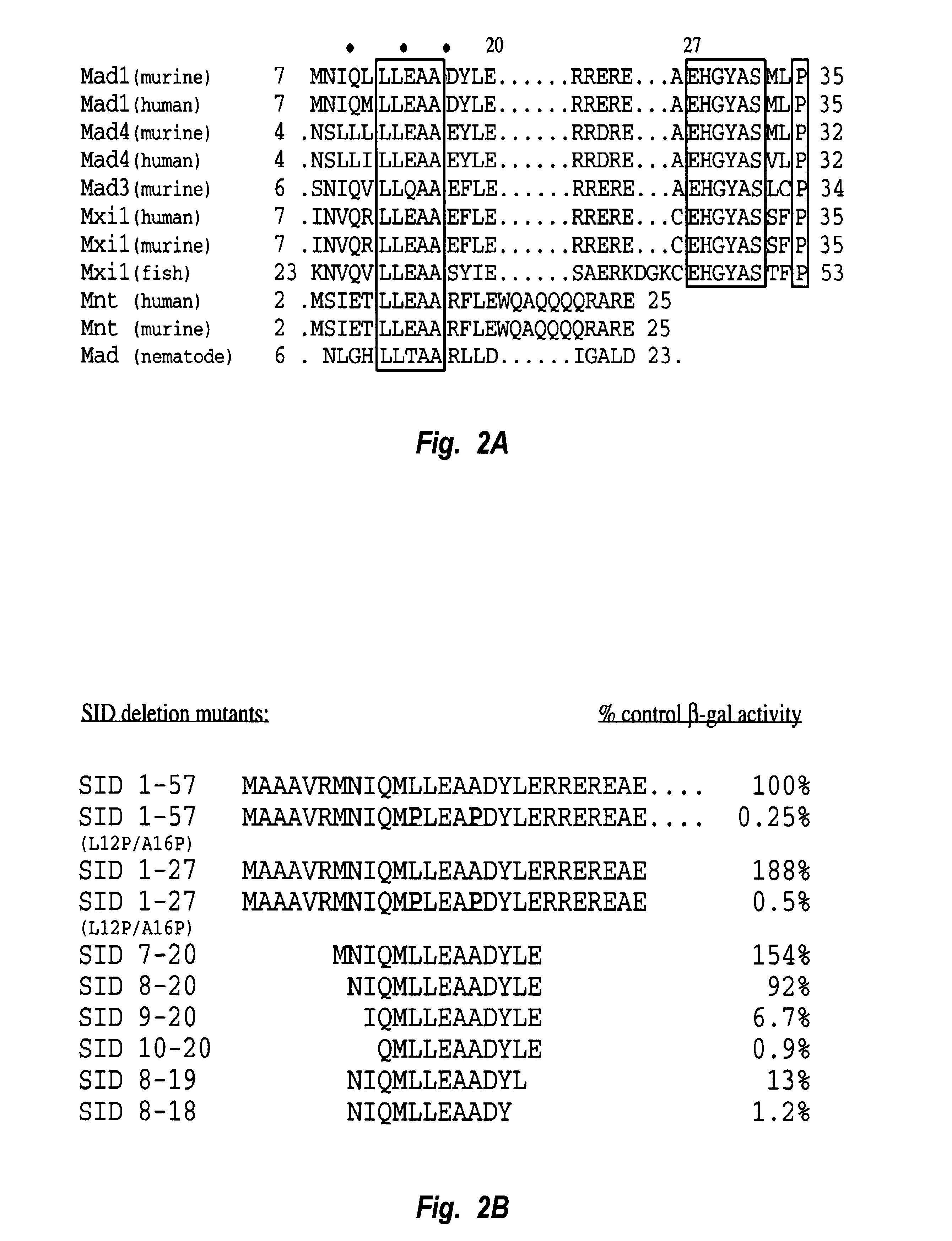Sid-polyamide fusions: a potent method of regulating gene expression
a technology of polyamide and fusion, which is applied in the field of sidpolyamide fusion, can solve the problems of mnt severely affecting the biological function of mad4, mnt is generally unimportant for stable interaction, and the charge residues in these activation domains are generally unimportant for stable interaction, and the knowledge of the structure of the target gene is required
- Summary
- Abstract
- Description
- Claims
- Application Information
AI Technical Summary
Problems solved by technology
Method used
Image
Examples
example 1
Mad1 and mSin3A Interact Directly
The abbreviations used herein are: HDAC1, histone deacetylase 1; HDAC2, histone deacetylase 2; bHLHZip, basic region-helix-loop-helix-zipper; SID, mSin3 interaction domain; PAH, paired amphipathic helix; CD, circular dichroism; TFE, trifluoroethanol; PBS, phosphate-buffered saline; GST, glutathione S-transferase; PVDF, polyvinylidene fluoride; GALDBD, GAL4 DNA binding domain; KID, kinase-inducible domain; deg, degree(s); PAGE, polyacrylamide gel electrophoresis.
Experimental Procedures. The experimental procedures employed in these Examples are as follows:
Cloning and Interaction Assays--Fusions to the LexA DNA binding domain were made either by polymerase chain reaction amplifying SID 1-57 and SID 1-27 using pSPMad1 or pSPMad1 (L12P / A16P) (Ayer et al., Cell 80:767-776 (1995)) as template or by inserting a double-stranded oligonucleotide cassette encoding the various SID constructs between the EcoRI and BamH1 sites of pBTM116. Hollenberg et al., Mol. C...
example 2
The SID is an Amphipathic Helix
Alignment of the Mad family proteins and Mnt from different species reveals that amino acids 7-35, numbering relative to Mad1, are highly conserved (FIG. 2A). Within this block of residues, the sequence LLEAA (residues 6-10 of SEQ ID NO: 2) is nearly identical between the aligned molecules, suggesting that it may form the core of the interaction domain. This block of conservation is followed by a stretch of charged amino acids and the sequence EHGYAS (residues 21-26 of SEQ ID NO: 2). These downstream sequence elements are highly conserved within the mammalian Mad proteins but are absent from the Mnt proteins and an invertebrate Mad homologue. Previous mutagenesis studies in which the first 35 amino acids of Mad1 were deleted have demonstrated that this conserved amino-terminal region is necessary for interaction between Mad proteins and mSin3A. Ayer et al., Cell 80:767-776 (1995). Another Mad1 truncation in which the first 20 amino acids of Mad1 are de...
example 3
Amino Acids 8-20 of Mad1 Function as a Portable Repressor Domain
Our mutational analysis suggests that a thirteen amino acid amphipathic .alpha.-helix mediates the interaction between the SID and PAH2. To test whether this minimal thirteen residue interaction domain is sufficient to target a functional mSin3:HDAC corepressor complex to DNA, we fused amino acids 8-20 from Mad1 to the DNA binding domain of the yeast transcriptional activator GAL4 (GALDBD). The transcriptional activity of GALSID(8-20) WT was tested on a reporter containing four GAL4 binding sites cloned upstream of a minimal promoter (FIG. 6A). Consistent with our previous findings (Ayer et al., Mol. Cell. Biol. 16:5772-5781 (1996)), the GALDBD alone activates this reporter approximately 3-fold, and a fusion between the first 35 amino acids of Mad1 and the GALDBD repressed this level of reporter activity approximately 7-fold. GALSID(8-20) WT repressed transcription to approximately the same level when fused to the GAL4 ...
PUM
| Property | Measurement | Unit |
|---|---|---|
| pH | aaaaa | aaaaa |
| size | aaaaa | aaaaa |
| structure/function analysis | aaaaa | aaaaa |
Abstract
Description
Claims
Application Information
 Login to View More
Login to View More - R&D
- Intellectual Property
- Life Sciences
- Materials
- Tech Scout
- Unparalleled Data Quality
- Higher Quality Content
- 60% Fewer Hallucinations
Browse by: Latest US Patents, China's latest patents, Technical Efficacy Thesaurus, Application Domain, Technology Topic, Popular Technical Reports.
© 2025 PatSnap. All rights reserved.Legal|Privacy policy|Modern Slavery Act Transparency Statement|Sitemap|About US| Contact US: help@patsnap.com



